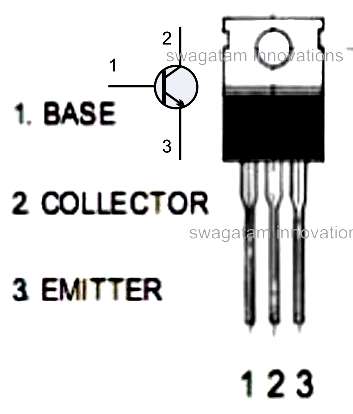The article relates us with the important features and specifications of MJE13005 device, which is a high voltage, high speed transistor, applicable for many different electronic circuit designs.
Let's try to understand the pin outs and technical specs of the device:
Pinout Diagram

Main Features
- Package - TO-220AB (typically recommended)
- Type - NPN Silicon
- Power Handling Capaciy - 75 Watts,
- Maximum Current Handling Capacity - 4 Amps
- Maximum Voltage Handling Capacity - Not less than 400V
Main Application Areas
High voltage circuits, switch mode power supplies, motor control, switching regulators, inverters, solenoid drivers.
Maximum Tolerable Ratings
- Maximum sustainable collector to emitter voltage = 400V DC (700V DC pulsed)
- Maximum tolerable emitter to base voltage = 9V DC
- Maximum sustainable collector to emitter current = 4 amps (8 amps pulsed)
- Maximum continuous base current = 2 amps (4 amps pulsed)
Technical Specifications
- Base emitter saturation voltage = typically 1.2V
- DC current gain (hFE) = typically around 20 to 60
- Application Circuits
A couple of application circuits using the MJE13005 have been discussed in the following articles:
Simple Transformerless Power Supply
Hi Swagatam,
The dual-UV tubes from my fish pond have stopped working. I checked the two filaments (about 9 ohms each) and found them to be good. I extracted the dual tubes from their glass casing and removed the driver board, which contains dual full-wave rectifiers, two 13005 transistors and associated components, including what looks like a small transformer or choke on the output side. I powered the board up (220VAC) and found that one of the outputs measures 12VDC but the other has zero out. I tried connecting the working output to one of the tubes but it doesn’t light.
I was hoping you could give me some guidance as to how these UV tubes work, working voltage, etc?
Very grateful for any advice/guidance you can offer.
Thanks in advance
Hi Robert,
As far as I know, UV lamps require high frequency, high voltage of over 200 V to light up. The transformer consists of a low voltage winding to provide the discharge current supply across the tube and a 240V winding to generate a initial static voltage for starting the tube conduction.
If your transformer is not producing the high voltage then the circuit could be malfunctioning probably due to a blown transistor. The fault can be confirmed by practically checking the circuit.
Sir can i use 13005 transistor to design 12v dc to 220v ac Inverter
And can i use 13005 to build induction heater
Loki, MJE13005 is suitable for high voltage applications, not for 12V or 24V applications, so no you cannot use it for inverter or induction circuits.
Sir is ampere is the problem here
If yes can i use many transistor (13005) in parallel to increase it
you can put them in parallel but use a common heatsink for all of them which are in parallel.
https://www.homemade-circuits.com/transistor-facts/
I connected 12 13005 in parallel so total ampere of 12*4=48
But still it get heated up when i conected it to my Inverter. The original transistor of my inverter is irfz44(mosfet) which is not available in my area where as 13005 is available at really cheap
you will have to use a very large heatsink, and single heatsink for the all the BJTs on each channel…two separate heatsinks for the two channels.
If it is cheap then it could duplicate one.
You should try other recommended ones like 2N3055, TIP35 etc.
Dir sir,can I made an 1000 watts inverter using MJE13005??
you can may be, if the DC input is at 330V
Dear sir, can I made an 100-120watts inverter using MJE13005?
Chandrachur, yes that may be possible if the input is 310V DC
Sir,
Good morning thanks for your quick reply
Sorry sir seller told me this. So I asked you to confirm .BJT have any other equivalent number?
satheesh, both the devices are rated to work at high voltages, but BT136 is specified to work with AC while MJE with DC…so are entirely different in that respect.
Sir,
Good day to you
Can I use this BT136-600D instead of (MJE13005 , TO-220AB )
satheesh, BT136 is a triac, whereas MJE13005 is a BJT, both cannot be interchnaged